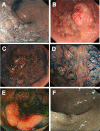Colorectal endoscopic submucosal dissection: patient selection and special considerations
- PMID: 28761366
- PMCID: PMC5516776
- DOI: 10.2147/CEG.S120395
Colorectal endoscopic submucosal dissection: patient selection and special considerations
Abstract
Endoscopic submucosal dissection (ESD) enables en bloc resection of large complex colorectal superficial neoplastic lesions, resulting in very low rates of local recurrence, high-quality pathologic specimens for accurate histopathologic diagnosis and potentially curative treatment of early adenocarcinoma without resorting to major surgical resection. The safety and efficacy of the technique, which was pioneered in the upper gastrointestinal tract, has been established by the consistently impressive outcomes from expert centers in Japan and some other eastern countries. However, ESD is challenging to perform in the colorectum and there is a significant risk of complications, particularly in the early stages of the learning curve. Early studies from western centers raised concerns about the high complication rates, and the impressive results from Japanese centers were not replicated. As a result, many western endoscopists are skeptical about the role of ESD and few centers have incorporated the technique into their practice. Nevertheless, although the distribution of expertise, referral centers and modes of practice may differ in Japan and western countries, ESD has an important role and can be safely and effectively incorporated into western practice. Key to achieving this is meticulous lesion assessment and selection, appropriate referral to centers with the necessary expertise and experience and application of the appropriate technique individualized to the patient. This review discusses the advantages, risks and benefits of ESD to treat colorectal lesions and the importance of preprocedure lesion assessment and in vivo diagnosis and outlines a pragmatic rationale for appropriate lesion selection as well as the patient, technical and institutional factors that should be considered.
Keywords: colorectal ESD; endoscopic resection; endoscopic submucosal dissection.
Conflict of interest statement
Disclosure The authors report no conflicts of interest in this work.
Figures



Similar articles
-
AGA Institute Clinical Practice Update: Endoscopic Submucosal Dissection in the United States.Clin Gastroenterol Hepatol. 2019 Jan;17(1):16-25.e1. doi: 10.1016/j.cgh.2018.07.041. Epub 2018 Aug 2. Clin Gastroenterol Hepatol. 2019. PMID: 30077787 Review.
-
Feasibility of colorectal endoscopic submucosal dissection (ESD) carried out by endoscopists with no or little experience in gastric ESD.Dig Endosc. 2017 Apr;29 Suppl 2:58-65. doi: 10.1111/den.12814. Dig Endosc. 2017. PMID: 28425662
-
Using Endoscopic Submucosal Dissection as a Routine Component of the Standard Treatment Strategy for Large and Complex Colorectal Lesions in a Western Tertiary Referral Unit.Dis Colon Rectum. 2018 Jun;61(6):743-750. doi: 10.1097/DCR.0000000000001081. Dis Colon Rectum. 2018. PMID: 29722731
-
How to establish endoscopic submucosal dissection in Western countries.World J Gastroenterol. 2015 Oct 28;21(40):11209-20. doi: 10.3748/wjg.v21.i40.11209. World J Gastroenterol. 2015. PMID: 26523097 Free PMC article. Review.
-
How Is Endoscopic Submucosal Dissection for Gastrointestinal Lesions Being Implemented? Results from an International Survey.GE Port J Gastroenterol. 2020 Jan;27(1):1-17. doi: 10.1159/000501404. Epub 2019 Sep 6. GE Port J Gastroenterol. 2020. PMID: 31970235 Free PMC article.
Cited by
-
Endoscopic resection of colorectal circumferential and near-circumferential laterally spreading lesions: outcomes and risk of stenosis.Int J Colorectal Dis. 2019 May;34(5):829-836. doi: 10.1007/s00384-019-03254-w. Epub 2019 Feb 19. Int J Colorectal Dis. 2019. PMID: 30783739
-
Novel non-curable resection prediction model for early colorectal cancer following endoscopic submucosal dissection based on inflammatory immune index.Front Med (Lausanne). 2025 May 8;12:1489842. doi: 10.3389/fmed.2025.1489842. eCollection 2025. Front Med (Lausanne). 2025. PMID: 40406409 Free PMC article.
-
Learning endoscopic submucosal dissection in the UK: Barriers, solutions and pathways for training.Frontline Gastroenterol. 2020 Sep 22;12(7):671-676. doi: 10.1136/flgastro-2020-101526. eCollection 2021. Frontline Gastroenterol. 2020. PMID: 34917325 Free PMC article. No abstract available.
-
Surgical resection after endoscopic resection in patients with T1 colorectal cancer: a meta-analysis.Int J Colorectal Dis. 2021 Mar;36(3):457-466. doi: 10.1007/s00384-020-03752-2. Epub 2020 Oct 27. Int J Colorectal Dis. 2021. PMID: 33111966 Review.
-
High burden of polyp mischaracterisation in tertiary centre referrals for endoscopic resection may be alleviated by telestration.Frontline Gastroenterol. 2022 Jun 22;14(1):32-37. doi: 10.1136/flgastro-2022-102161. eCollection 2023. Frontline Gastroenterol. 2022. PMID: 36561787 Free PMC article.
References
-
- Hirao M, Masuda K, Asanuma T, et al. Endoscopic resection of early gastric cancer and other tumors with local injection of hypertonic saline-epinephrine. Gastrointest Endosc. 1988;34(3):264–269. - PubMed
-
- Deyhle P, Largiadèr F, Jenny S, Fumagalli I. A method for endoscopic electroresection of sessile colonic polyps. Endoscopy. 1973;5(01):38–40.
-
- Yokota T, Sugihara K, Yoshida S. Endoscopic mucosal resection for colorectal neoplastic lesions. Dis Colon Rectum. 1994;37(11):1108–1111. - PubMed
-
- Lai LH, Chan FK. Endoscopic submucosal dissection for colonic lesions: why and how should we do it? J Dig Dis. 2011;12(4):229–233. - PubMed
-
- Gotoda T, Kondo H, Ono H, et al. A new endoscopic mucosal resection procedure using an insulation-tipped electrosurgical knife for rectal flat lesions: report of two cases. Gastrointest Endosc. 1999;50(4):560–563. - PubMed
Publication types
LinkOut - more resources
Full Text Sources
Other Literature Sources
Medical
Research Materials
Miscellaneous

